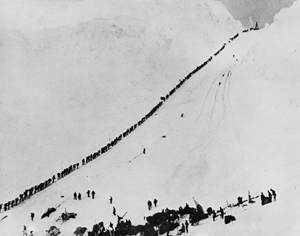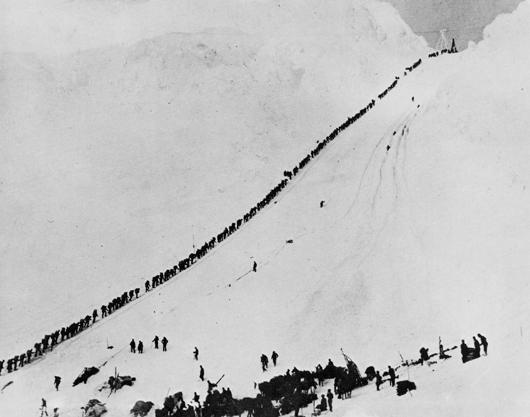
FAIRBANKS, Alaska (AP) – Last spring, without much warning, an elderly woman quietly dropped off a cache of old documents and photos at the Washington offices of the Alaska Commercial Company.
That low-key deposit, from the widow of the late AC President John Larson, is now illuminating life in pre-territorial 19th century Alaska. The collection brings to life a colorful snapshot in Alaska’s history — the era when it abruptly shifted from being a Russian colony to a U.S. territory.
Kegs of lard, 25-pound shipments of dry mustard, barrels of tar and even a new safe were among the items recorded in invoice logs being shipped to the largely uninhabited frontier. The records are all written in immaculate cursive handwriting, showing products delivered by companies such as Taylor & Bender Wholesale Grocers, “sole agents for Dr. Hufeland’s celebrated Swiss stomach bitters.”
The Alaska Commercial Company donated the documents last month to the University of Alaska Fairbanks Rasmuson Library, which is working to record and parse through the details of the intriguing collection. They provide a deeper understanding of a sometimes blurry period in Alaska history.
Dennis Moser, department head of UAF’s Alaska and Polar Regions Collections and Archives, said the collection already includes lots of material from the era, but in “dribs and drabs” that don’t always add up to a larger view of everyday life. A log book of items that were shipped to the port of St. Michael and Yukon River villages in about 1870 provides clarity in a sometimes blurry period.
“It says everything about what people were doing at that time,” Moser said.
The invoices include the earliest known shipment of “Bost. Pilot Bread” into Alaska, with 25 cases entering the state on Oct. 4, 1869. Pilot bread — a sturdy, non-perishable cracker — remains a staple of rural Alaska diets.
It also showed the powerful link between San Francisco merchants and Alaska in the years after Russia sold the area to the United States. Dozens of companies from the city are represented in the invoice book — Goodwin & Co., Hawley & Co. Importers of Jobbers and Hardware among them — providing everything from nails to peanuts for the remote outposts.
Turning over the documents to UAF is important to AC Company president Rex Wilhelm, whose more than 200-year-old company dates back to days of Russian ownership, when it was known as the Russian American Company. Wilhelm has a job steeped in such history that he can trace his title back to the famed fur-trader Alexander Baranov, the first governor of Russian Alaska.
The position has helped make him an amateur historian at AC, working to uncover historic documents from online auctions or old records. For a company that dates back to 1799, he said, there are surprising gaps in its history.
“There’s just a lot to look at, but the unfortunate thing is that we didn’t have a lot of the heritage materials you’d expect of a company 200 years old,” Wilhelm said.
Wilhelm actually mailed Larson’s widow a decade ago inquiring about old records, but heard nothing until they were dropped off last spring. He said the deeply private woman didn’t provide details about how the collection of invoice books, drawings and more than 600 photographs had been stored, but he said it was a thrilling gift.
The collection also includes detailed color drawings of each turn-of-the-century Northern Commercial Company store, with vivid enough backgrounds that the site of each building could still be located today.
“I would think that archaeologists, if they wanted to go back and see where some things could be found, could use them for that,” Wilhelm said.
Maritime historian J. Pennelope Goforth, of Anchorage, helped facilitate the transfer of the documents between the AC Company and UAF, which will work to preserve the delicate papers and photos.
Moser said the records are particularly fascinating because the significance of items purchased by Alaskans in the 1870s can be easily grasped by modern residents of the state. The AC Company and its predecessors are a big part of that history, he said.
“When you have an institution that has a very deep significance, you want to include them in the story,” Moser said. “We’re excited to get this — they’re an extremely significant player.”
___
Information from: Fairbanks (Alaska) Daily News-Miner, http://www.newsminer.com
# # #
Copyright 2012 Associated Press. All rights reserved. This material may not be published, broadcast, rewritten, or redistributed.
ADDITIONAL IMAGE OF NOTE



